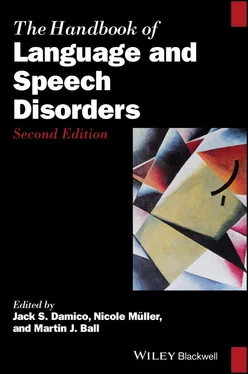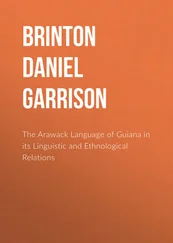With regard to language abilities beyond the level of single words, the general picture suggests that morpho‐syntactic abilities may be more impaired than vocabulary skills (Chapman, 2006). Children with DS have also been compared to children with SLI on the accuracy of marking finiteness in spontaneous speech. The study found that the profiles of the groups of children were similar, suggesting that grammatical abilities in children with DS are comparable to those of children with known language impairments (Eadie, Fey, Douglas, & Parsons, 2002). Few studies have investigated early language development beyond single words in DS. Oliver and Buckley (1994), using parental report, showed that two‐word combinations emerged between 25 and 52 months (mean age of around 36 months) in English‐speaking children with DS. Two decades later, Levy and Eilam (2013) reported that Hebrew‐speaking children with DS started using word combinations at approximately 55 months of age. Levy and Eilam further argued for an atypical trajectory of language development in DS due to its delayed onset and slowed pace. The only study to our knowledge that has investigated longitudinally the early stages of vocabulary and general language acquisition, by Mason‐Apps, Stojanovik, Houston‐Price, Seager, and Buckley (2020), reports that expressive communication and expressive vocabulary developed at the same rate and level in children with DS aged between 18 and 35 months compared with typically developing (TD) controls aged between 9 and 23 months, who were matched to the DS group on gains in nonverbal mental ability over a period of 12 months. Interestingly, the infants with DS showed a receptive language advantage over the TD group; this group’s auditory comprehension and receptive vocabulary scores were superior to those of the TD group when nonverbal mental ability was accounted for, hence showing a receptive language advantage at this early stage of language development.
With regard to social communication skills, it has been shown that people with DS are very keen to engage in conversation and to keep the conversation going, but they often lack the appropriate language skills to do so (Rondal, 2001). Two studies described in Abbeduto and Murphy (2004) point to some strengths and weaknesses in the DS communication profile. For example, in a barrier task, individuals with DS were less likely than typically developing individuals matched for nonverbal mental age to provide listeners with referential frames to help the listener’s comprehension. Also, they were less likely than mental age‐matched peers to signal non‐comprehension, suggesting that perhaps they were unable to monitor their own comprehension, which can seriously disrupt the conversational interaction. On the other hand, individuals with DS were found to be appreciative of shared knowledge in conversation and they made appropriate shifts from indefinite descriptions (such as: “a house”) to definite descriptions (such as: “the house”). In a task that required the participants to describe a novel shape to their interlocutor, the individuals with DS were found to be very consistent when describing the same shape every time it occurred, suggesting awareness of the listener’s informational needs.
Research also shows that children with DS as young as 6 years old experience impaired pragmatic communication, showing a profile of relative strengths and weaknesses. Specifically, after controlling for nonverbal mental age, the children with DS scored at or below 1 SD of the TD norm on all subscales of the Norwegean adaptation of the Children’s Communication Checklist‐2 (Helland, Biringer, Helland, & Heimann, 2009) apart from the nonverbal communication scale. Nonverbal communication emerged as a relative strength, which is in line with other studies, such as Franco and Wishart (1995) and John and Mervis (2010).
In summary, research studies so far point to the fact that children with DS have difficulties with language, and these difficulties can sometimes be more severe than expected for the general level of cognitive abilities. However, findings are mixed and reflect differences in methodology, age of participants, and the heterogeneity of the DS population. There is evidence that language abilities in DS may develop atypically, but more research is needed to determine the characteristics of the atypical language trajectory.
Considering the studies reported above with regard to language and communication abilities for these two genetic syndromes, Williams and Down syndrome, points to uneven neurocognitive profiles and areas of relative strengths and weaknesses in each of the populations. There is no systematic and consistent evidence from the two disorders for clear dissociations between different cognitive skills, which may partially be due to heterogeneity within each of the syndromes, possibly small sample sizes, different methodologies, and other yet unknown factors. It is very important that inquiry into language and communication impairments in genetic syndromes continues if we are to understand the effects of genes on the development of cognitive profiles. As pointed out by Rice, Warren, and Betz (2005), although we have a lot of information with regard to individual diagnostic profiles of different syndromes, there are few comparative studies, and therefore there is much need for systematic comparisons across disorders if we are to fully understand what is common across conditions and what is syndrome‐specific, so that we can clarify the nature of language, communication, and other cognitive impairments. One way forward would definitely be longitudinal studies detailing how language is acquired in the context of cognitive development, and how development of language and communication skills proceeds and interacts with other cognitive domains in different disorders. In order to inform theories of language acquisition and address more directly the debate with regard to the neural specialization of different modules from birth, it is crucial to examine language and cognitive abilities from as near to the infant start‐state as possible. This kind of research has started to emerge and has the potential to make a significant difference to existing knowledge.
1 Abbeduto, L., & Murphy, M. M. (2004). Language, social cognition, maladaptive behaviour, and communication in Down syndrome and fragile X syndrome. In M. L. Rice & S. F. Warren (Eds.), Developmental language disorders: From phenotype to aetiologies (pp. 77–97). Mahwah, NJ: Lawrence Erlbaum Associates.
2 Abbeduto, L., Warren, S. F., & Conners, F. A. (2007). Language development in Down syndrome: From the prelinguistic period to the acquisition of literacy. Mental Retardation and Developmental Disabilities Research Reviews, 13, 247–261.
3 Bellugi, U., Bihrle, A., Neville, H., & Doherty, S. (1992). Language, cognition and brain organization in a neurodevelopmental disorder. In M. Gunnar & C. Nelson (Eds.), Developmental behavioral neuroscience: The Minnesota symposium (pp. 201–232). Hillsdale, NJ: Lawrence Erlbaum Associates.
4 Bellugi, U., Linchtenberger, L., Lai, Z., & St.George, M. (2000). The neurocognitive profile of Williams syndrome: A complex pattern of strengths and weaknesses. Journal of Cognitive Neuroscience, 12(supplement), 7–29.
5 Bellugi, U., Marks, S., Bihrle, A., & Sabo, H. (1988). Dissociation between language and cognitive functions in Williams syndrome. In D. Bishop & K. Mogford (Eds.), Language development in exceptional circumstances (pp. 177–189). London, UK: Churchill Livingstone.
6 Bellugi, U., Wong, P., & Jernigan, T. L. (1994). Williams syndrome: An unusual neuropsychological profile. In S. H. Broman & J. Grafman (Eds.), Atypical cognitive deficits in developmental disorders: Implications for brain function (pp. 23–56). Hillsdale, NJ: Lawrence Erlbaum Associates.
Читать дальше












